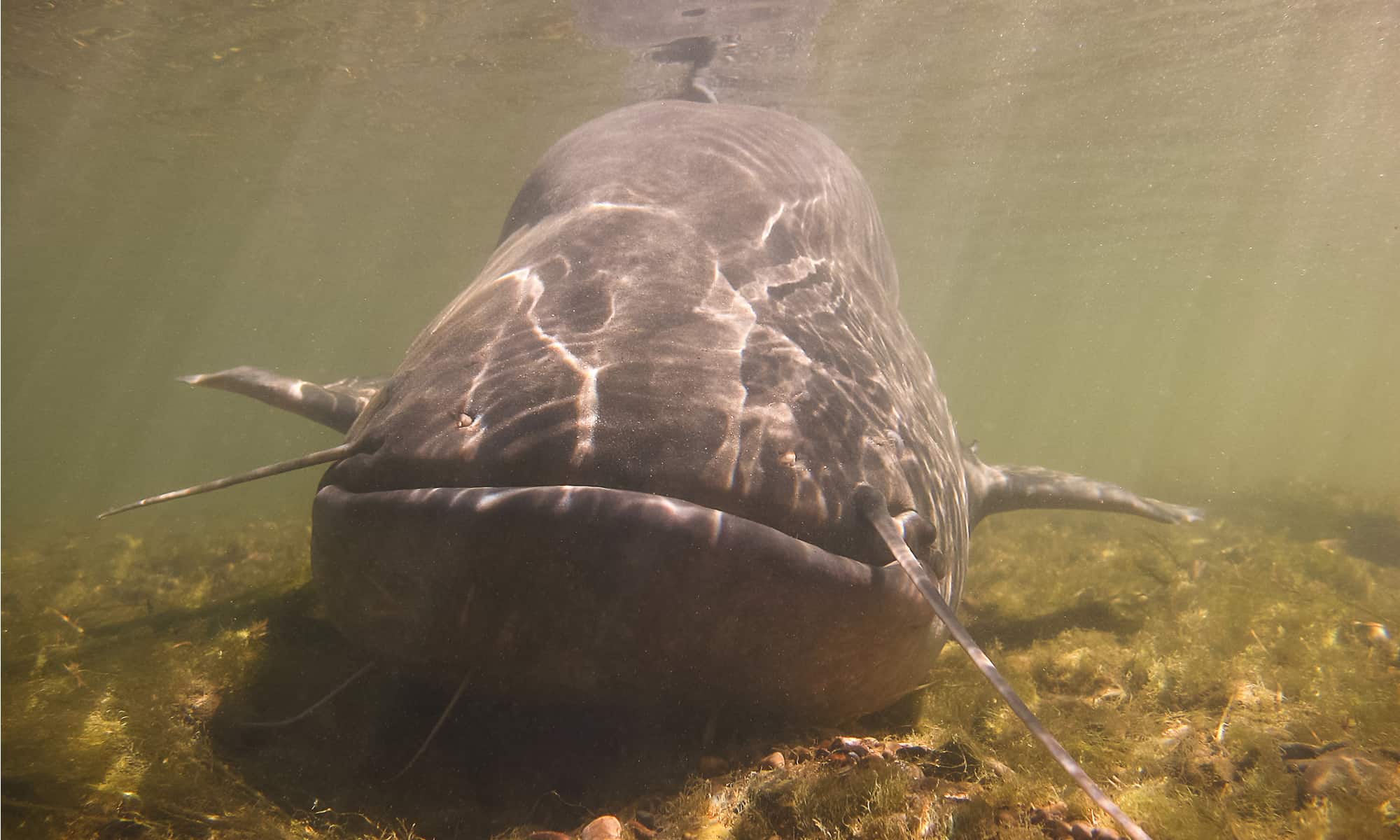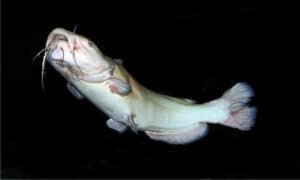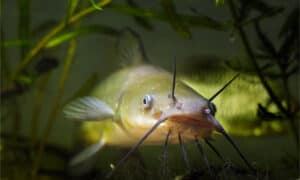Wels catfish can grow to be as big as a Christmas tree—with some stretching to nearly double that size. Not only is this freshwater catfish gigantic, but it’s also highly adaptable, and capable of living as long as a human.
Inhabiting the bottoms of rivers and lakes, wels catfish have several adaptations that make them dangerous predators. But that doesn’t mean you have anything to be afraid of. Their appetites are reserved for prey such as fish, turtles, frogs, and the occasional flock of pigeons. Using a killer whale-like beaching technique, these massive catfish can beach themselves, where they gulp down pigeons with their over-sized mouths and curved teeth.
Even though wild catfish don’t target people, there are still a few dangers you should be aware of. Many catfish have venomous spines that can be as painful as a sting from a stingray. Anglers have to be extra careful after catching this behemoth, or risk getting punctured.
What else should you know about wels catfish? Read on to learn more about this amazing creature.
Are Wels Catfish Dangerous?
Wels catfish are normally calm and peaceful creatures, who are more interested in gobbling up fish and frogs than targeting people. A lot of experts believe they would never see humans as prey. However, it’s wise to give them plenty of space to avoid an encounter in the first place.
There are a lot of stories out there about these catfish taking human victims. Of course, there haven’t been any proven incidences as of yet. There was one wels catfish that was believed to have human remains in its stomach, but it turned out to be the remains of a whale shark.
About Wels Catfish
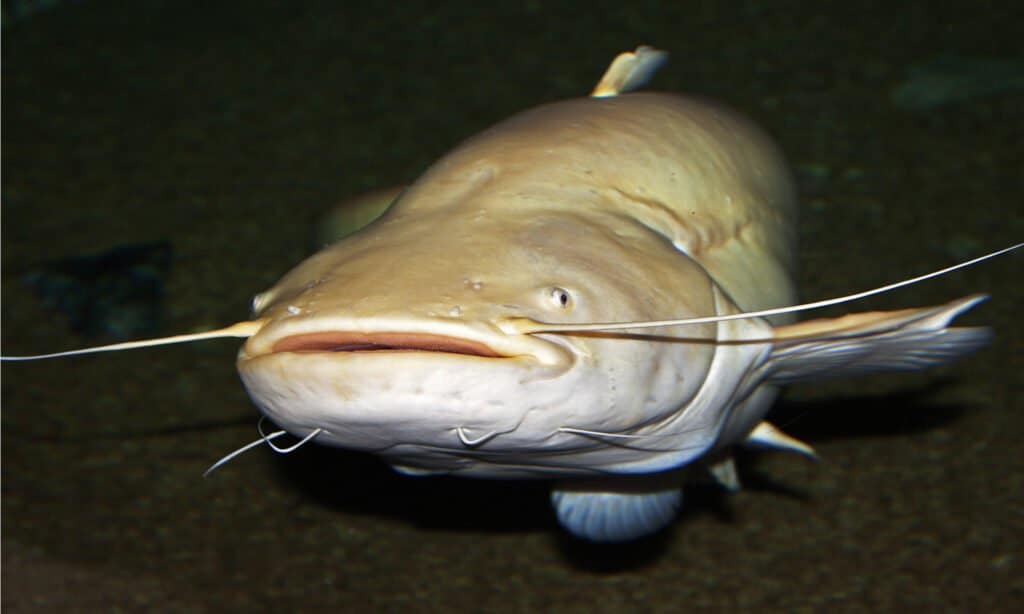
On average wels catfish weigh anywhere between 300 to 600 pounds, but can grow larger.
©Bildagentur Zoonar GmbH/Shutterstock.com
Wels catfish are one of the largest freshwater fish species. Their green-black bodies can grow over 10 feet long, with some growing beyond the 15-foot mark. These fish are completely scale-less and have a flat tail. Their long slimy bodies make them look like an oversized slug when they’re out of water.
Just like their length fluctuates, their weight varies too. On average they weigh anywhere between 300 to 600 pounds, but sometimes they’re even heavier. Some people say they’ve seen ones weighing 800 pounds, but there’s not much proof to support these claims.
They Have Crooked Teeth
These giants have triangular-shaped heads and a mega-mouth made for munching. Their head is so big, it takes up about a quarter of their body. They also have tiny, dense bristle-like teeth called cardiform on their upper and lower jaw barbels. These cardiform teeth do double duty—firmly grip their prey, and help grind them. Their teeth’s curvature plays a key role in this gripping and grinding strategy. As for barbels, they’ve got six of those whisker-like things around their mouth that help them hunt. The barbels allow them to taste, smell, and forage for food in low-visibility water conditions.
Real Danger: Mishandling
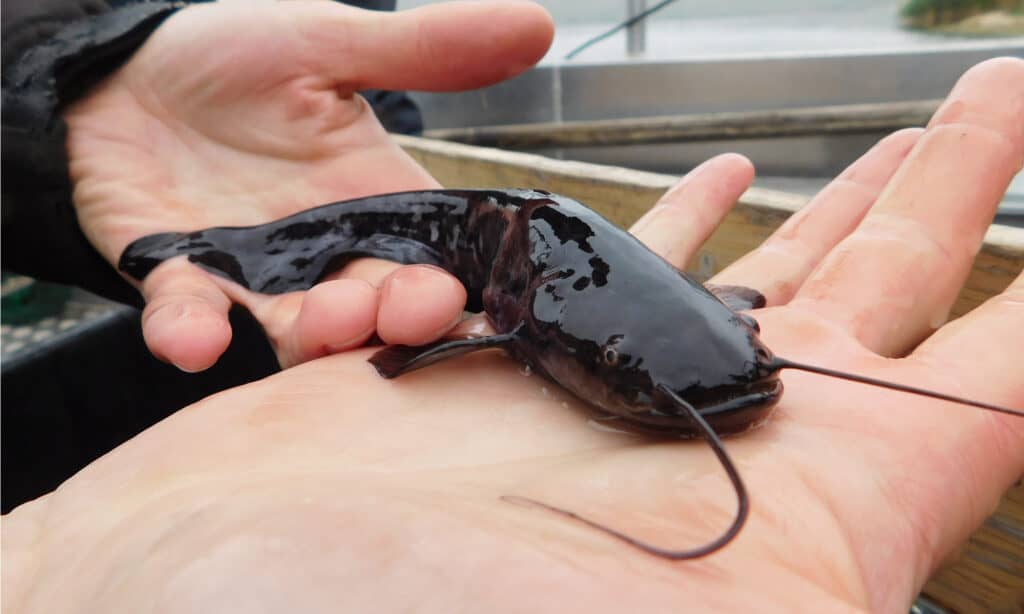
Anglers have to be careful even when handling young wels catfish since they have venomous spines.
©Michaela Holubova/Shutterstock.com
Mishandling catfish is what makes them dangerous. These fish possess sharp spines on their dorsal and pectoral fins. So, there’s always the risk of accidental punctures. Thankfully, using appropriate protective gear such as gloves helps minimize the risk of injury.
Venomous Spines
Catfish can have venom in their spines. And while it isn’t deadly, it can be extremely painful. Catfish venom causes blood cells to break, damages the skin, leads to swelling, and constricts blood vessels. It’s about as severe as one a stingray could deliver. Symptoms may include localized swelling, redness, inflammation, and in some cases, infection.
The location of the puncture usually determines how severe it is. In 2009 and 2011, two incidents of catfish stings were reported at Noor and Ali Asghar Hospital, Isfahan University of Medical Sciences. The injuries included cuts, bleeding, swelling, and redness in the affected area, along with some pretty intense pain.
Kuno the Dachshund Eating Catfish

Kuno the Killer was a legendary wels catfish that ate a dachshund puppy.
©iStock.com/JLSnader
Did you hear about the famous dog-eating catfish in Germany? “Kuno the Killer”, first earned his reputation after leaping out of the water to swallow a dachshund puppy whole. For years, this massive catfish evaded numerous attempts to catch him.
The monstrous fish was never caught, but his carcass is believed to have been found. Extreme heat and low water levels are probably what did him in. After the find, some locals made plans to stuff the legendary fish and display it in a museum. However, some believe the carcass isn’t the actual body, and that “Kuno the Killer” is still out there somewhere.
Biggest Wels Catfish Ever Caught

The largest wels catfish on record was 9.4 feet long, and was caught by angler Alessandro Biancardi.
©Podolnaya Elena/Shutterstock.com
The biggest wels catfish ever caught was an impressive 9.4 feet long. Angler, Alessandro Biancardi, caught the megafish in the River Po, Lombardy region, Italy. Wels catfish first were introduced to the River Po around 2,000.
The fish was so large and strong, that the angler almost lost his Jon boat after bringing it aboard. It was a 43-minute battle, with every moment holding the possibility he might lose the fish. It wasn’t until he got his boat into the shallows Biancardi was able to land and control the massive catfish. Experts put the fish at around 20-30 years of age, which is young compared to how old these fish can get. Some wild catfish live 80 years or longer.
To avoid stressing out the fish any further, Biancardi chose to forego weighing it and safely released it instead. Yet, despite not recording the weight, the pictures make it easy to imagine the fish weighed hundreds of pounds. Factors like high temperatures, and abundant food contributed to its monster size.
Here are a few more anglers who caught record gigantic wels catfish:
9 Foot Catch
Stefan Seub and Christian Ritzinger caught a wels catfish that was 9.22 feet long and weighed 308 pounds. They caught the fish from the River Po, after a long 25-year pursuit by the anglers.The catch briefly held the record for the longest wels.
8.7 Foot Catch
Markus Brock and Benjamin Grunder landed a humongous 8.79-foot wels catfish in the River Po. It was a challenging fight, that they almost lost several times. After a 20-minute battle, they were able to successfully land the fish.
220 Pound Catch
Ditch Ballard caught an 8-foot-long, 222-pound wels catfish in Spain’s Ebro River. He says it was the biggest battle of his fishing career. He fought the fish in freezing cold weather as it dragged his boat nearly half a mile down the river.
How Do Wels Catfish Get So Large?
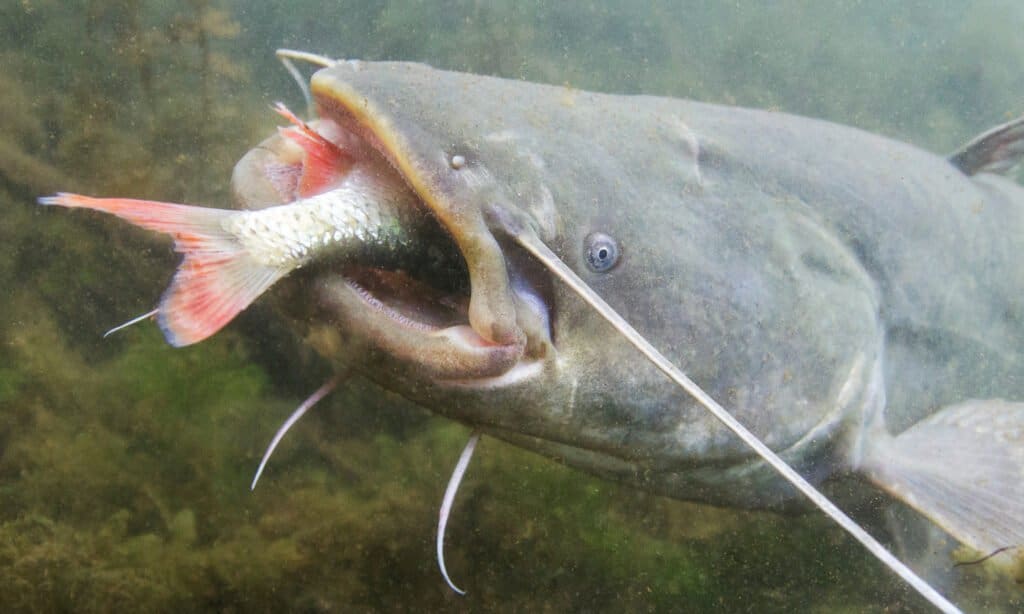
Wels catfish like to gulp down their prey which includes animals like frogs, crayfish, and mollusks.
©Rostislav Stefanek/Shutterstock.com
When the water is warm and there’s plenty of food, catfish grow fast. At ten years old, they can reach a length of about 5 feet. Along with warm water, they also need plenty of food to reach their monstrous sizes.
Wels catfish are active hunters. Rather than waiting for a meal to swim by, they’re always out exploring for food. And their diet changes as they grow. Young catfish focus on eating phytoplankton, while adults target fish, crayfish, mollusks, frogs, and more. They also change where they hunt, shifting from shoreline to mid-channel habitats during the first year of life.
Another reason these fish grow so large is because they live so long. Researchers at Linnaeus University conducted a decade-long study on this red-listed species, which led to the discovery that this species can live for more than 70 years.
Sports Fish or Invasive Species?

Wels catfish are highly sought after by anglers because they’re humongous, and put up a big fight.
©Dudarev Mikhail/Shutterstock.com
Wels catfish are considered a sport fish because of their size and predatory behaviors. They’re also an invasive species in some areas. Since they eat so much they can do some real damage to whatever area they’re invading. Wels catfish are omnivores. These nocturnal predators love eating fish, frogs, ducks, small mammals, and sometimes even birds.
How do they eat their prey? With a big gulp! Catfish can’t bite in the conventional sense because of their crooked teeth. Instead of chewing, they’re all about sucking and gulping down their meals.
Benthic Species: Ground Fish
Since they’re benthic fish, you can usually find wels catfish along the bottom of deep rivers, and warm lakes. They prefer muddy, weedy areas with still or slow-moving water. They’re native to the Baltic, Caspian, North, Black, and Aral Sea. Their native range spans from Eastern and Central Europe, all the way to Central Asia. They’ve even expanded their range into France, the Po River Valley in Italy, and the Mediterranean basin. And they also pop up in places like Brazil, China, and Algeria.
Catfish Never Stop Growing

Kangaroos
and wels catfish exhibit indeterminate growth; if conditions are right, they keep on growing.
©Elena Pochesneva/ via Getty Images
What do lobsters, kangaroos, and wels catfish have in common? They’re all animals that never stop growing. Wels catfish have indeterminate growth, which means if the conditions are right, they’ll keep growing for their entire lives.
Stunted Populations
Generally, slower-growing fish tend to live longer than faster-growing ones within the same species. Their indeterminate growth can lead to the development of slow-growing fish populations, often referred to as “stunted” populations. A stunted population of fish has too many fish growing slowly.
How Fast Do Wels Catfish Grow?
How fast do wels catfish grow? That answer depends on how the fish’s living. Food supply, habitat, water quality, and competition all determine how fast they grow and how big they get. On a farm, catfish can grow as fast as 1 pound in 18 months. But out in the wild, their growth rate varies more.
In the South of the UK, the wels catfish can grow at a super fast rate. While they’re not native to the UK, they’ve been introduced by anglers due to their ability to grow to massive sizes. On average they put on about 1-2 pounds per year. But, some places claim growth rates of almost 10 pounds per year.
The catfish grow faster in the South of the UK because the weather is warmer. The milder springs and autumns mean the catfish can eat for 2-3 more months each year. That’s 3 more months of growth the catfish up north don’t have.
Wels Catfish Love Ambushing Pigeons
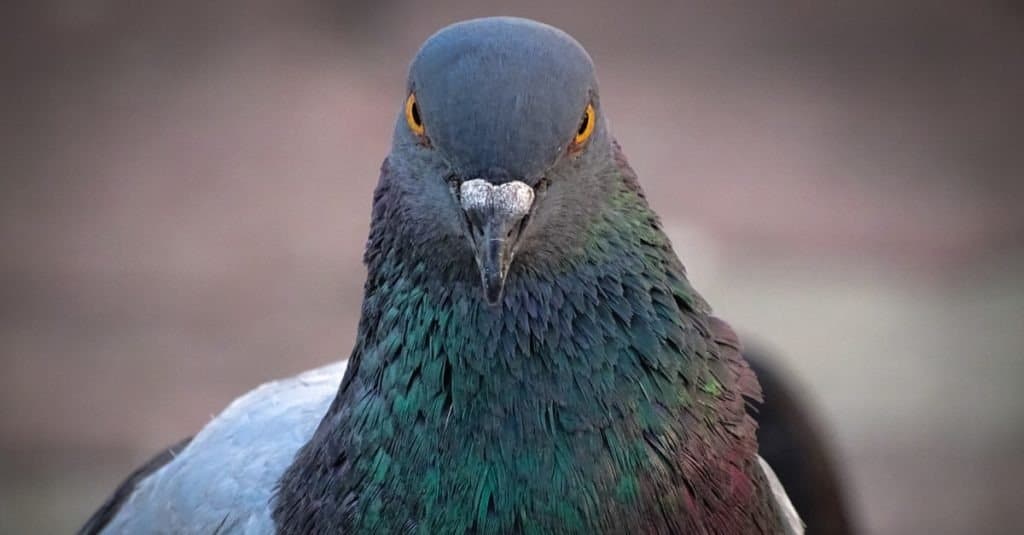
Pigeons are smart birds, but they haven’t evolved to be aware of aquatic threats like wels catfish.
©hkhtt hj/Shutterstock.com
Wels catfish are smart enough to use a killer whale hunting technique to catch unsuspecting pigeons. They patiently lurk in the shallows, waiting for pigeons to approach. Their highly sensitive barbells tune in for any moving birds. Then when the time’s right, they beach themselves, mouths open wide to swallow up any pigeons within reach. The larger the flock, the better. With a mouth as big as a wels catfish, they can fit more than one bird at a time. This has proven to be a strange, but successful strategy.
It also looks like younger catfish can learn this hunting style by watching their elders. But they have to be careful. Unlike killer whales, catfish require water for oxygen, so extended beaching could kill them.
Why target pigeons? Because they never see it coming. Pigeons have evolved to watch out for other birds that can cause them harm. But they’re pretty much oblivious when it comes to aquatic threats. They’ll hang out right by the water’s edge, without giving any thought to what lies beneath. Other fish that eat birds include northern pike, largemouth bass, and murray cod.
Catfish Are Swimming Tongues
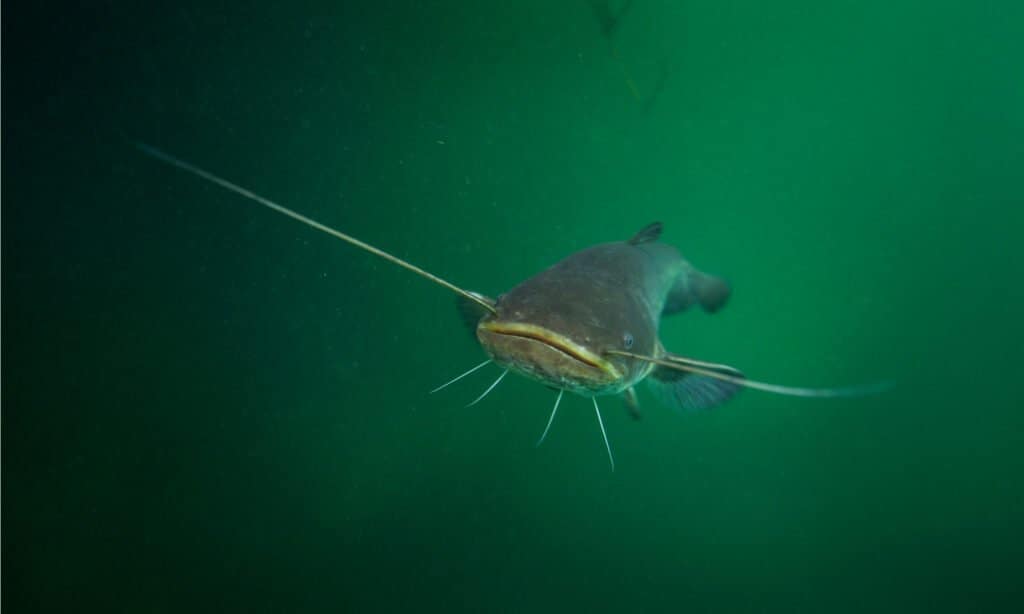
Wels catfish are nicknamed, “swimming tongues”, because they have taste buds from whiskers to tail.
©Martin Prochazkacz/Shutterstock.com
Catfish have sensitive skin that can detect touch, and special barbels for touching and feeling. But what’s even more amazing is their ability to taste the world around them. Catfish are the super-tasters of the animal kingdom, which has earned them the nickname of, “swimming tongues“. They have taste buds throughout their entire body, from whiskers to tails. This adaptation makes it easier for them to locate the prey they like while avoiding things they find unappetizing. They can taste even the slightest amount of amino acids coming off of prey items. Even if the concentration of amino acids is as little as one part per 10 billion parts of water, it’s enough to attract hungry catfish.
Final Thoughts on the Massive Catfish
There you have it! The full story on one of the world’s biggest catfish. The biggest wels catfish ever caught was an impressive 9.4 feet long. But there’s likely an even larger specimen out there since catfish have indeterminate growth. As long as they have warm water and plenty of food, these catfish can keep growing their entire lives. It’s possible some have even surpassed the 15-foot mark, and may even weigh somewhere around 800 pounds.
There’s no doubt about it, these fish are big, but their size isn’t the only chapter of their story. Wels catfish are also highly skilled hunters, using their sensitive barbells to detect even the slightest movements from prey. And despite their rumored exploits, these fish aren’t eyeing humans for a snack. They do however present a risk to anyone who doesn’t respect their space and those prickly spines.
Thank you for reading! Have some feedback for us? Contact the AZ Animals editorial team.

